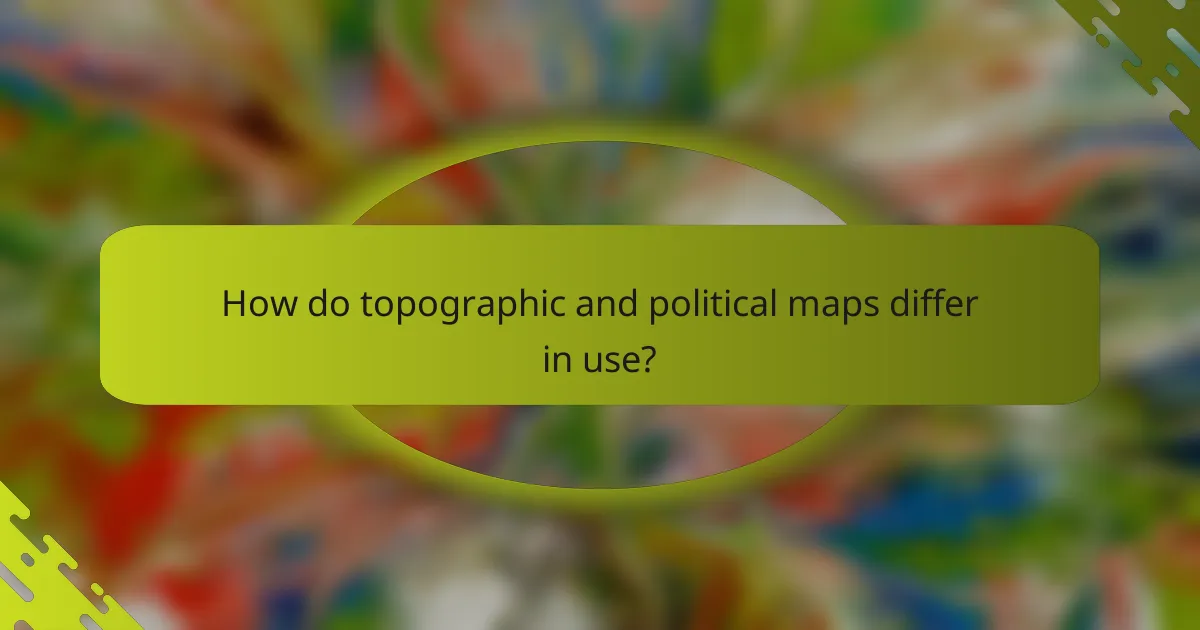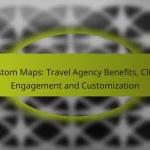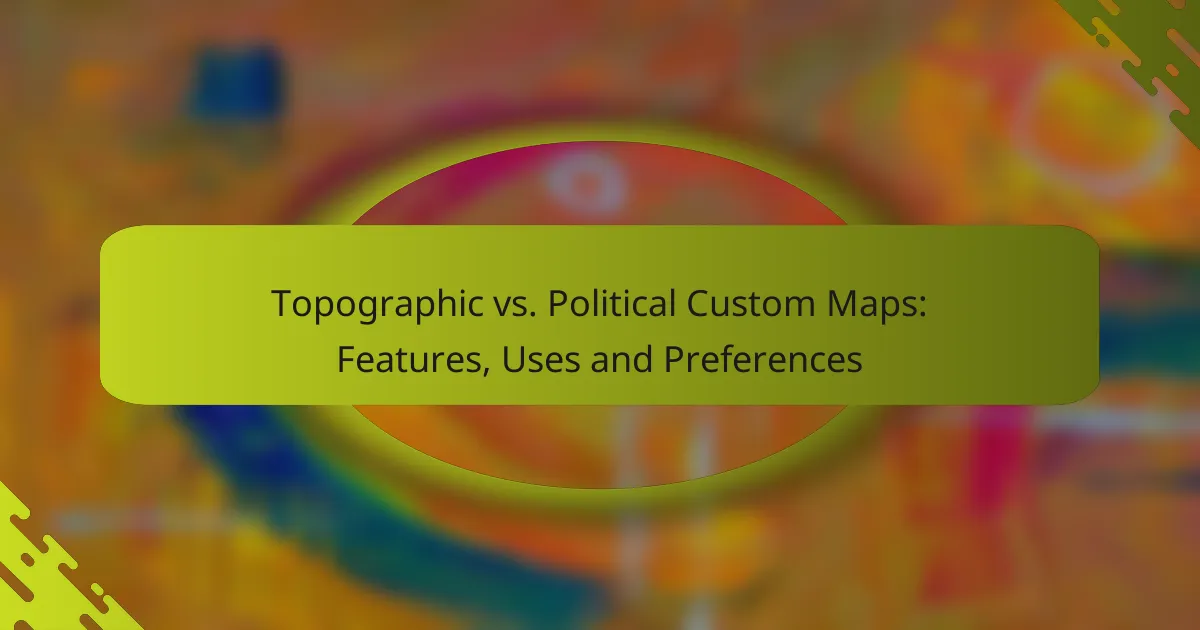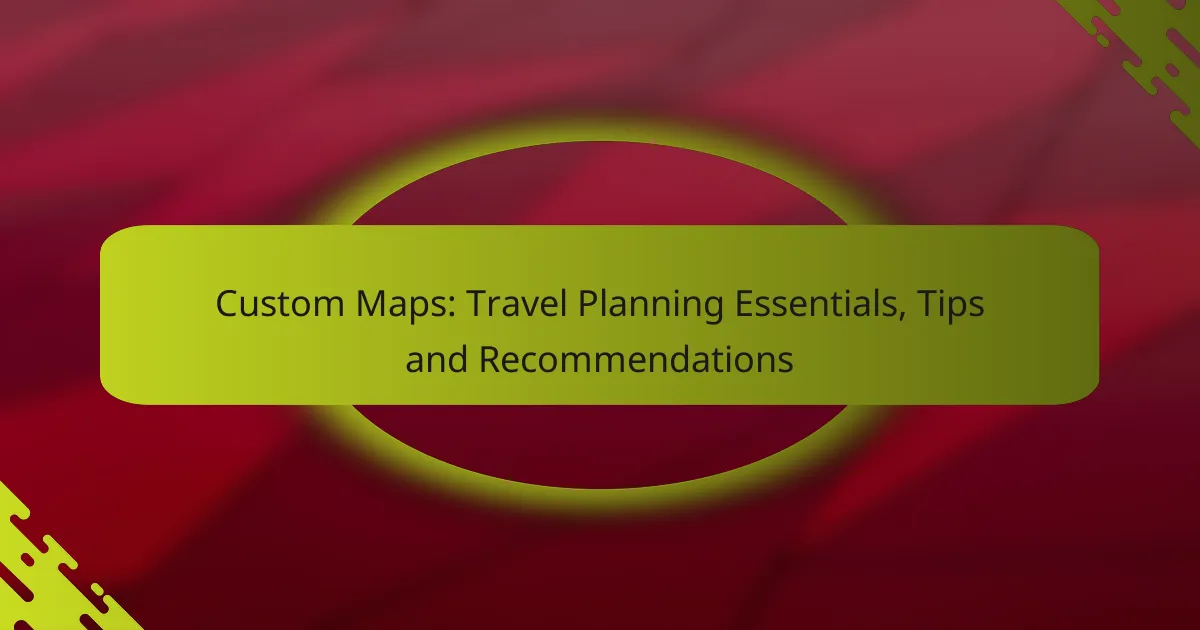Custom maps serve distinct purposes, with topographic maps emphasizing physical terrain features like elevation and landforms, making them invaluable for outdoor activities and land use planning. In contrast, political maps focus on administrative boundaries and governance structures, providing essential insights into the organization of regions, countries, and municipalities. Understanding the differences between these two types of maps can help users select the most appropriate tool for their specific needs.

What are the key features of topographic custom maps?
Topographic custom maps are specialized representations of terrain that emphasize elevation and landforms. They provide detailed information about the physical features of an area, making them essential for outdoor activities and land use planning.
Elevation representation
Elevation representation on topographic maps is typically shown through contour lines, which connect points of equal height above sea level. These lines help users visualize the steepness of slopes and the overall terrain profile. The closer the lines are to each other, the steeper the terrain.
In addition to contour lines, some maps may include shaded relief or color gradients to enhance the visual understanding of elevation changes. This can be particularly useful for hikers and climbers who need to assess the difficulty of a route.
Terrain details
Topographic maps provide detailed terrain features such as mountains, valleys, and plateaus. These details are crucial for understanding the landscape and planning routes for outdoor activities. Users can identify landmarks and natural barriers that may affect navigation.
Features like cliffs, depressions, and ridges are often marked with specific symbols, allowing for quick recognition. This level of detail helps outdoor enthusiasts make informed decisions about their routes and safety.
Water bodies and vegetation
Topographic maps indicate the location of water bodies, including rivers, lakes, and ponds, which are essential for navigation and resource planning. These features are typically represented in blue, making them easy to identify at a glance.
Vegetation types may also be shown, often through shading or symbols, indicating forests, grasslands, or wetlands. Understanding the distribution of vegetation can aid in wildlife observation and environmental studies.
Contour lines and gradients
Contour lines are the backbone of topographic maps, providing critical information about the terrain’s shape and slope. The spacing of these lines indicates the gradient; closely spaced lines suggest a steep slope, while widely spaced lines indicate a gentle slope.
Users should pay attention to the contour interval, which is the vertical distance between adjacent contour lines. Common intervals range from 5 to 50 meters, depending on the map’s scale and the terrain’s complexity.
Applications in outdoor activities
Topographic maps are invaluable for various outdoor activities, including hiking, mountain biking, and camping. They help users navigate challenging terrains and identify safe routes, making them essential tools for outdoor enthusiasts.
Additionally, these maps are used in land management, environmental studies, and urban planning. Understanding the terrain can influence decisions regarding construction, conservation, and recreation areas.

What are the key features of political custom maps?
Political custom maps primarily focus on depicting the various political boundaries and administrative structures within a specific area. These maps highlight divisions such as countries, states, and municipalities, making them essential tools for understanding governance and political organization.
Political boundaries
Political boundaries define the limits of governmental jurisdictions, such as countries, states, and provinces. These lines can be natural, like rivers and mountains, or artificial, drawn for historical or political reasons. Understanding these boundaries is crucial for identifying the areas of governance and jurisdictional authority.
For example, the boundary between the United States and Canada is defined by a mix of natural features and historical agreements. Political boundaries can change over time due to treaties, conflicts, or administrative decisions, impacting local governance and international relations.
Administrative divisions
Administrative divisions refer to the subdivisions within a political entity, such as counties, municipalities, or districts. These divisions are essential for local governance, resource allocation, and public service delivery. Each administrative unit typically has its own governing body and regulations.
In the United States, for instance, each state is divided into counties, which further break down into cities and towns. These divisions help streamline governance and ensure that local needs are addressed effectively.
Population density
Population density maps illustrate how many people live in a specific area, which can influence political representation and resource distribution. Areas with high population density may require different governance strategies compared to sparsely populated regions.
For example, urban areas often have more complex administrative needs due to higher population concentrations, while rural areas may focus on agricultural policies and land use. Understanding population density is vital for effective planning and resource management.
Voting districts
Voting districts are specific areas designated for electoral purposes, determining how residents vote for representatives. These districts are drawn based on population data and can significantly impact election outcomes and political representation.
In many countries, including the United States, gerrymandering can occur, where districts are manipulated to favor a particular political party. This practice raises concerns about fair representation and can lead to legal challenges.
Applications in governance and planning
Political custom maps are invaluable in governance and urban planning, aiding in decision-making processes for resource allocation, infrastructure development, and public services. They help policymakers visualize demographic trends and assess the needs of different regions.
For instance, a city planner might use a political map to identify areas with high population density that require additional public transportation services. By understanding the political landscape, planners can make informed decisions that benefit the community as a whole.

How do topographic and political maps differ in use?
Topographic maps focus on the physical landscape, showing elevation, terrain, and natural features, while political maps emphasize boundaries, cities, and human-made structures. Each type serves distinct purposes, influencing their applications in various fields.
Outdoor vs. urban planning
Topographic maps are essential for outdoor activities such as hiking, camping, and land surveying, as they provide detailed information about elevation changes and natural landmarks. In contrast, political maps are more useful for urban planning, helping city planners visualize zoning, infrastructure, and population distribution within defined boundaries.
Recreational vs. administrative purposes
Recreational users, such as hikers and outdoor enthusiasts, prefer topographic maps for their ability to illustrate trails, water bodies, and elevation contours. On the other hand, political maps serve administrative purposes, aiding government agencies and organizations in policy-making, resource allocation, and demographic analysis.
Audience preferences
Different audiences have varying preferences based on their needs. Outdoor enthusiasts typically favor topographic maps for their detailed terrain information, while educators and policymakers often rely on political maps to understand governance and regional demographics. Understanding these preferences can help in selecting the appropriate map type for specific tasks or projects.

What are the advantages of using topographic maps?
Topographic maps offer several advantages, primarily their ability to represent terrain features in detail. They are essential for understanding elevation changes, landforms, and natural features, making them invaluable for outdoor activities and planning.
Enhanced navigation
Topographic maps significantly improve navigation by providing detailed information about the landscape. Users can identify trails, roads, and natural landmarks, which help in determining the best routes for travel. The contour lines indicate elevation changes, allowing for better planning of ascents and descents.
When using topographic maps for navigation, look for key features such as water bodies, ridges, and valleys. These elements can serve as reference points to ensure you stay oriented in unfamiliar terrain.
Detailed terrain analysis
Topographic maps facilitate detailed terrain analysis by showcasing variations in elevation and landforms. This information is crucial for activities such as land surveying, environmental studies, and urban planning. Understanding the terrain helps in assessing potential challenges like steep slopes or flood-prone areas.
For effective terrain analysis, pay attention to contour intervals, which indicate the steepness of slopes. Closer contour lines suggest steeper terrain, while wider intervals indicate gentler slopes. This knowledge can guide decisions in construction or land use.
Support for hiking and camping
Topographic maps are particularly beneficial for hikers and campers, as they provide essential information about trails, campsites, and water sources. They help outdoor enthusiasts plan their trips by identifying suitable routes and potential hazards, such as cliffs or dense forests.
When preparing for a hiking or camping trip, consult a topographic map to evaluate the difficulty of the terrain and the availability of resources. Look for established trails and nearby water sources to ensure a safe and enjoyable experience in the wilderness.










